Only death or divorce will get you a spot in the coveted first row on an Italian beach. In a country where there is a socialistic equality in most things – health care, long lines at the post office, job security, good food – the beach is not one of them. In the U.S., if you get up early enough, you can stake out the best piece of sand on almost any shore and you can usually have a couple of yards between you and your nearest neighbor.
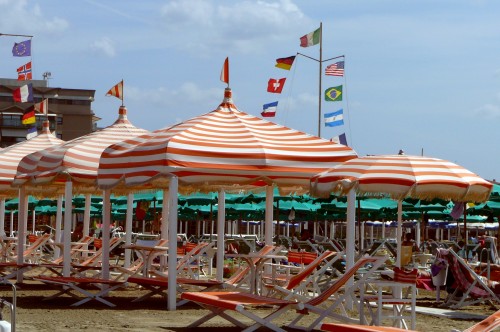
In Italy, the best spot is already taken – everywhere. This prime real estate is a ten foot square piece of sand on the front row (closest to the waterline) in one of the hundreds of beach stations (stabilimenti balneari or bagni) that line the sandy beach along the gently rolling Tyrrhenian Sea from Rome to Cinque Terre. It is only obtained through patience or primogeniture.
This, of course, is not the natural sea-washed, wind-ruffled, kid-pocked, littered and shell-strewn beach of the States or Britain. No, this is ten feet of perfectly groomed sand, topped by a large beach umbrella, a beach chair, two matching sling-back chairs and a long lounge with attached sun-shade.
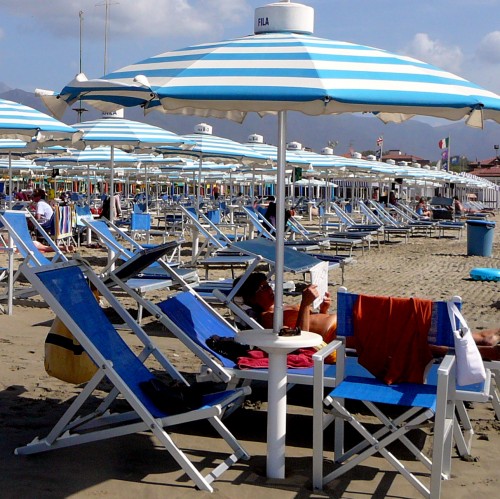
It’s crowded, especially after the allowable five people move into the space. It’s more crowded when the neighboring umbrellas on either side are raised and their quota of five people each arrive. But ,of course, if you have a spot on the front row, you know everyone around you – they have been friends, or even family, for decades.
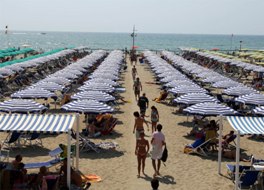
Each summer Italians spend as much time as possible, not only in the same seaside town, or at the same bagno, but on the same spot of sand, the same distance from the same sea. They frequently rent the spot for three to four months each year. When no member of the extended family is present between the months of May to mid-September, no one else is allowed to sit under their umbrella, on their chairs, or on their ten-square feet of sand.
For Americans who for the most part don’t spend the summer holidays in the same place twice, this shows an astonishing commitment or a sad lack of imagination. But this is not unusual for Italians. A recent study showed that over 70% of Italians take their 30 to 60 days of vacation each summer at the same time and over 65% spend that holiday time in the exact same place every year.
Perhaps it is the chaos of their history and politics that push Italians into a comfortable conformity in their private lives. They have a sense of humor about it all. In the 1960s, Piero Focaccia, a popular singer, warbled this tune:
Per quest’anno, non cambiare.
Stessa spiaggia, stesso mare.
For this year, don’t change
Same beach, same sea.
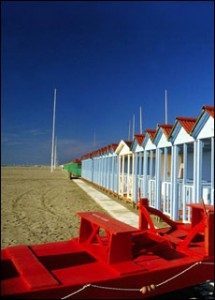
Italy is blessed with beaches, both east on the Adriatic Sea or the west on the adjoining seas: Ligurian, Tyrrhenian, as well as the southern Ionian Sea. The personalities of the coasts are clearly defined. The east coast has thousands of stabilimenti lined up at Rimini, Ancona, San Benedetto and Lido di Jesolo, south to Pescara. The sea is flat and tepid, but the beaches rock with discos and luna parks. The west coast has more rambunctious seas, but seems to have a more placid beach life, fewer teenagers looking to hook up, more groups of three or four middle-aged ladies standing knee deep in the water gossiping. Italians are opinionated and loyal – those that favor the east coast, do not let the west coast sand slide through their toes.
Actually, there is not a lot of sand-toe contact on the Italian beaches. Once the Italian family (this is not a solitary pastime; you only go to the beach with family or friends) selects its preferred coast, picks a town to match their socio-economic class (Forte dei Marmi for high-rollers, Viareggio and Lido di Camaiore for the well-to-do, Lido di Massa Carrara for the middle class) and puts down one to five thousand euro for the sixteen summer weeks (mid-May to mid-September) at a bath station, they will have a combination of the following amenities: a parking lot, an entry portico, a receptionist (for day or weekly renters), a bar or café, showers (mostly cold, some hot for a fee), toilets, changing cabins, restaurant, fresh- or sea-water pool (higher end establishments), video games, fooseball tables, boardwalks to the sea (wood, plastic, or rubber), a bagnino (lifeguard cum umbrella jockey cum sand raker), a flag pole with colored flags (red if sea is too rough), paddle boats for rent, and a rescue rowboat for the bagnino.
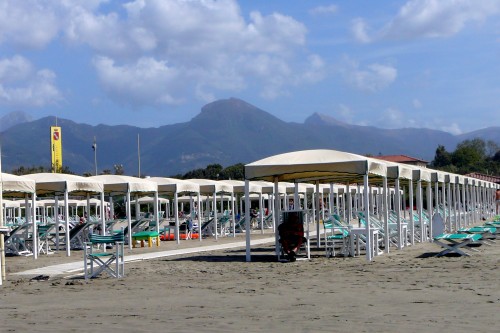
For the American with an exaggerated sense of personal space, the Italian beach scene, although colorful, can seem claustrophobic. For the Italian it is a joyful place of friends and family – teenagers fall in love, get married ten years later, socialize and play cards with other couples, have children – who play as babies/toddlers/teenagers, and then fall in love and start the cycle all over again.
As the summer ends and the ombrelloni are put away, Italians say goodbye to their beach mates with promises of “Stessa spiaggia, stesso mare” next year.
